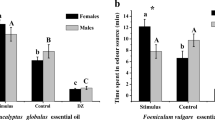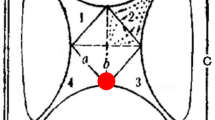Abstract
The brown planthopper (BPH), Nilaparvata lugens, is a serious insect pest in rice cultivation, while Cyrtorhinus lividipennis, its main predator, feeds on BPH eggs and nymphs. The artificial release of C. lividipennis could significantly suppress the increase in BPH and prevent hopper burn in the open field. How to attract the artificially released C. lividipennis to the precise location of the target rice field is key for successful biological control. However, there have been few reports related to C. lividipennis. In the current study, we identified two attractant compounds for C. lividipennis from plant essential oils. Using olfactometer assays, we found that Coriandrum sativum and Nerium indicum essential oils were highly attractant to both adults and nymphs of C. lividipennis. The petroleum ether fractions of C. sativum, N. indicum, and Alpinia officinarum essential oils were analyzed with GC-MS. According to previous reports and the results of the GC-MS analysis, we selected ten compounds to screen their attractancy to C. lividipennis. After the olfactometer assays, we identified isocaryophyllene and trans-2-dodecenol, which were the most effective attractants to C. lividipennis under laboratory conditions. Our experiments under greenhouse and field conditions showed that isocaryophyllene and trans-2-dodecenol presented significant attractancy to C. lividipennis. These results highlight the potential of isocaryophyllene and trans-2-dodecenol as effective attractants to aid C. lividipennis in locating target rice fields during their artificial release. Further studies are required to develop a formulation that would increase efficacy with lower costs.





Similar content being viewed by others
References
Alhmedi A, Haubruge E, Francis F (2010) Identification of limonene as a potential kairomone of the harlequin ladybird Harmonia axyridis (Coleoptera: Coccinellidae). Eur J Entomol 107:541–548
Ammagarahalli B, Chianella L, Gomes P, Gemeno C (2017) Role of plant volatiles and hetero-specific pheromone components in the wind tunnel response of male Grapholita molesta (Lepidoptera: Tortricidae) to modified sex pheromone blends. Bull Entomol Res 107:573–582
Areekul S, Sinchaisri P, Tigvatananon S (1988) Effects of Thai plant extracts on the oriental fruit fly III. Attractancy test. J (Nat Sci) Kasetsart 22(2):160–164
Barud FJ, Lopez S, Tapia A, Feresin GE, Lopez ML (2014) Attractant, sexual competitiveness enhancing and toxic activities of the essential oils from Baccharis spartioides and Schinus polygama on Ceratitis capitata Wiedemann. Ind Crop Prod 62:299–304
Chen YP, Liu Q, Li M, Wang XJ, Zhang LL, Cao LJ, Qie BR (2016) EAG and behavioral responses of Chlorophorus diadema to six volatiles from Caragana kroshinskii. Chin J Appl Entomol 53(3):632–641
Cook SM, Khan ZR, Pickett JA (2007) The use of push-pull strategies in integrated pest management. Annu Rev Entomol 52:375–400
Dong K, Chen B, Li ZY, Dong Y, Wang HL (2010) A characterization of rice pests and quantification of yield losses in the japonica rice zone of Yunnan, China. Crop Prot 29:603–611
Fiedler AK, Landis DA (2007) Attractiveness of Michigan native plants to arthropod natural enemies and herbivores. Environ Entomol 36:751–765
Flint HM, Merkle JR, Sledge M (1981) Attraction of male Collops vittatus in the field by caryophyllene alcohol. Environ Entomol 10:301–304
Hanula JL, Sullivan BT, Wakarchuk D (2013) Variation in manuka oil lure efficacy for capturing Xyleborus glabratus (Coleoptera: Curculionidae: Scolytinae), and cubeb oil as an alternative attractant. Environ Entomol 42:333–340
Isman MB, Miresmailli S, Machial C (2011) Commercial opportunities for pesticides based on plant essential oils in agriculture, industry and consumer products. Phytochem Rev 10:197–204
Johnson SD, Steiner KE, Kaiser R (2005) Deceptive pollination in two subspecies of Disa spathulata (Orchidaceae) differing in morphology and floral fragrance. Plant Syst Evol 255:87–98
Kaplan I (2012) Attracting carnivorous arthropods with plant volatiles: The future of biocontrol or playing with fire? Biol Control 60:77–89
Katerinopoulos HE, Pagona G, Afratis A, Stratigakis N, Roditakis N (2005) Composition and insect attracting activity of the essential oil of Rosmarinus officinalis. J Chem Ecol 31:111–122
Khan ZR, Saxena RC (1986) Varietal resistance in rice against Sogatella furcifera (Horváth). Crop Prot 5:15–25
Koczor S, Knudsen GK, Hatleli L, Szentkiralyi F, Toth M (2015) Manipulation of oviposition and overwintering site choice of common green lacewings with synthetic lure (Neuroptera: Chrysopidae). J Appl Entomol 139:201–206
Kunkel BA, Cottrell TE (2007) Oviposition response of green lacewings (Neuroptera: Chrysopidae) to aphids (Hemiptera: Aphididae) and potential attractants on pecan. Environ Entomol 36:577–583
Liu F (2001) Volatiles mediated intra-and interspecific interactions among rice planthoppers and their natural enemies. Dissertation, Zhejiang University
Liu Y, Guo GX, Chen JL, Ni HX (2005) Behavioral and electrophysiological responses of four predatory insect species to semiochemicals of wheat. Acta Entomol Sin 48(2):161–165
Losel P, Penners G, Weissmuller J (1998) U.S. Patent No. 5,707,638. U.S. Patent and Trademark Office, Washington, DC
Lou YG, Cheng JA (2003) Role of rice volatiles in the foraging behavior of the predator Cyrtorhinus lividipennis for the rice brown planthopper Nilaparvata lugens. Biocontrol 48:73–86
Lou YG, Zhang GR, Zhang WQ, Hu Y, Zhang J (2014) Reprint of: biological control of rice insect pests in China. Biol Control 68:103–116
Mao GF, Mo XC, Fouad H, Abbas G, Mo JC (2018) Attraction behaviour of Anagrus nilaparvatae to remote lemongrass (Cymbopogon distans) oil and its volatile compounds. Nat Prod Res 32:514–520
Matsumura M, Urano S, Suzuki Y (2005) Evaluating augmentative releases of the mirid bug Cyrtorhinus lividipennis to suppress brown planthopper Nilaparvata lugens in open paddy fields. In: Toriyama K et al (ed) Rice is life: scientific perspectives for the 21st century. Proceedings of the World Rice Research Conference held in Tsukuba, Japan, 4–7 November 2004, pp 473–475 ref.10
Miller DR, Borden JH (2000) Dose-dependent and species-specific responses of pine bark beetles (Coleoptera: Scolytidae) to monoterpenes in association with pheromones. Can Entomol 132:183–195
Minyard JP, Hardee DD, Gueldner RC, Thompson AC, Wiygul G, Hedin PA (1969) Constituents of the cotton bud compounds attractive to the boll weevil. J Agric Food Chem 17:1093–1097
Morris MC, Li FY (2000) Coriander (Coriandrum sativum) “companion plants” can attract hoverflies, and may reduce pest infestation in cabbages. N Z J Crop Hortic Sci 28:213–217
Mossa ATH (2016) Green pesticides: essential oils as biopesticides in insect-pest management. J Environ Sci Technol 9:354–378
Nishida R, Tan KH (2016) Search for new fruit fly attractants from plants: a review. In: Proceedings of the 9th international symposium on fruit flies of economic importance, 12–16 May 2014, Bangkok, Thailand. International Fruit Fly Steering Committee, pp 249–262
Pingel RL, Epsky ND, Goenaga R (2006) Field trials of lures to attract fruit flies (Diptera: Tephritidae) in commercial sapodilla, mamey sapote, and carambola orchards in Puerto Rico. J Agric Univ P R 90:109–113
Preap V, Zalucki MP, Jahn GC, Nesbitt HJ (2001) Effectiveness of brown planthopper predators: population suppression by two species of spider, Pardosa pseudoannulata (Araneae, Lycosidae) and Araneus inustus (Araneae, Araneidae). J Asia Pac Entomol 4:187–193
Preetha G, Stanley J, Suresh S, Samiyappan R (2010) Risk assessment of insecticides used in rice on miridbug, Cyrtorhinus lividipennis Reuter, the important predator of brown planthopper, Nilaparvata lugens (Stal.). Chemosphere 80:498–503
Rapusas HR, Bottrell DG, Coll M (1996) Intraspecific variation in chemical attraction of rice to insect predators. Biol Control 6:394–400
Reyes TM, Gabriel BP (1975) The life history and consumption habits of Cyrtorhinus lividipennis Reuter (Hemiptera: Miridae). Philipp Entomol 3:79–88
Sun B, Zhang LX, Yang LZ, Zhang FS, Norse D, Zhu ZL (2012) Agricultural non-point source pollution in China: causes and mitigation measures. Ambio 41:370–379
Wang P, Lou YG (2013) Screening and field evaluation of synthetic plant volatiles as attractants for Anagrus nilaparvatae Pang et Wang, an egg parasitoid of rice planthoppers. Chin J Appl Entomol 50(2):431–440
Williams L, Rodriguez-Saona C, Castle SC, Zhu S (2008) EAG-active herbivore-induced plant volatiles modify behavioral responses and host attack by an egg parasitoid. J Chem Ecol 34:1190–1201
Xie SA, Ding Y (2010) Semiochemicals of Dendroctonus armandi. J North East For Univ 38(1):91–94
Xie XW, Yang Z, Chen X, Su GL, Chen B, Yan NS, Dong WX (2015) Effects of volatiles from corn ear on the larval feeding behavior of the Asian corn borer, Ostrinia furnacalis. Plant Prot 41(6):92–97
Yang ZH, Bengtsson M, Witzgall P (2004) Host plant volatiles synergize response to sex pheromone in codling moth, Cydia pomonella. J Chem Ecol 30:619–629
Yao YJ, Cai WL, Yang CJ, Xue D, Huang YZ (2008) Isolation and characterization of insecticidal activity of (Z)-asarone from Acorus calamus L. Insect Sci 15:229–236
Zhang YH (2016) Study on attractant effect of rice volatiles on Chilo suppressalis and rice parasitoid wasps. Dissertation, Zhejiang University
Zhang X, Xu QJ, Lu WW, Liu F (2015) Sublethal effects of four synthetic insecticides on the generalist predator Cyrtorhinus lividipennis. J Pest Sci 88:383–392
Zhang JY, Lin KJ, Huang XZ, Geng T, Wei HY, Zhang YJ (2016) EAG responses and taxis selection of green plant bug Apolygus lucorum to volatiles from seven species of kinds of Malvaceae plants. Chin J Biol Control 32(2):135–141
Zhu PY, Lu ZX, Heong K, Chen GH, Zheng XS, Xu HX, Yang YJ, Nicol HI, Gurr GM (2014) Selection of nectar plants for use in ecological engineering to promote biological control of rice pests by the predatory bug, Cyrtorhinus lividipennis, (Heteroptera: Miridae). PLoS ONE 9(9):e108669
Acknowledgements
This study was supported by the Special Fund for Agro-scientific Research in the Public Interest, China (201403030).
Author information
Authors and Affiliations
Corresponding author
Ethics declarations
Conflict of interest
The authors declare that they have no conflict of interest.
Additional information
Communicated by M. Traugott.
Electronic supplementary material
Below is the link to the electronic supplementary material.
Rights and permissions
About this article
Cite this article
Liu, S., Zhao, J., Hamada, C. et al. Identification of attractants from plant essential oils for Cyrtorhinus lividipennis, an important predator of rice planthoppers. J Pest Sci 92, 769–780 (2019). https://doi.org/10.1007/s10340-018-1054-1
Received:
Revised:
Accepted:
Published:
Issue Date:
DOI: https://doi.org/10.1007/s10340-018-1054-1




